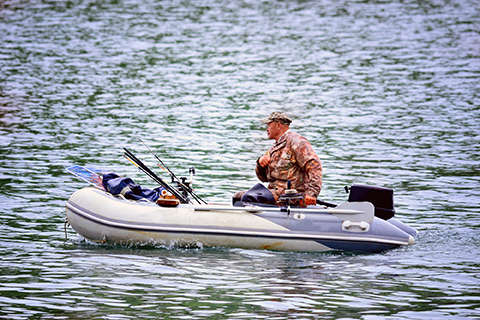There are many advantages top fishing from a boat in contrast to fishing from a shore.

fisherman floats on an inflatable boat on a fishing trip
Perhaps the biggest advantage of all is that you will be able to access areas of the water that you otherwise would not have been able to.
But of course, owning a boat means that you also need to take ownership over the various responsibilities of it as well, and there are certain steps that you must take to prepare your boat before each fishing season.
As you’ll soon see, simply launching your boat into the water without a care in the world is not the right way to go about it.
Here are the three steps that you must follow for preparing your boat for fishing:
Step #1 – Ensure The Boat Is Licensed
First and foremost, the vast majority of jurisdictions in the United States require that if your boat is of an extended length, it must also be licensed. Licensed boats will feature a sticker attached to the side that identifies the jurisdiction, with a series of identification numbers and letters.
The specific regulations in regards to boat licensing vary by state and it’s your responsibility to research them. For example, some states have agreements so that if a boat is licensed in one state, the bordering states will also recognize it.
You may also need to license your boat’s trailer as well. Take note that while the boat will most likely need to be licensed through the fish and game department of your state, the trailer will likely need to be licensed through your state’s department of motor vehicles.
Step #2 – Install A Trolling Motor
And don’t just install a trolling motor: check your existing motor to see if it’s maintained properly (assuming you have one).
Trolling motors are small electric motors located at the back of the boat and used to maneuver through the boat in a way that is as quiet and disturbs the water as little as possible. The purpose behind it, of course, is to avoid spooking fish in way that a traditional motor would.
If you don’t yet have a trolling motor and need to purchase one, always try to buy one with higher power. If you don’t, you may regret not having the added power later when you need it. And even if you don’t end up using the added power, at least you still have the option for if you need it in the future.
Some trolling motors also quire you to control them with your foot by way of a folding mounting bracket, but they can also be more difficult to operate (as they utilize mechanical cables for this purpose).
Trolling motors that are easier to install and utilize will be tiller steer motors, which simply clamp to the back of your boar with a few screws.
Step #3 – Gather The Necessary Safety Equipment
Besides fishing equipment, you need safety equipment in your fishing vessel as well. Some safety items will be required by the law, while others will just be wise to have with you even if it’s not required by the government.
One example of what you will need are life jackets. Specifically, you need one life jacket per person. Even if it’s just you, having two or three onboard will be smart.
The next thing you need is a kill switch. Clip to your belt and the engine will then shut off on its own if you are thrown from the boat. Not all jurisdictions require kill switches, but it will still be smart to have one.
Also get a weather NOAA radio, which will keep you updated to weather or temperature changes in the area.
Finally, also gather signaling devices (flares and an air horn), rope or Paracord, at least one fire extinguisher, a flashlight, and lights that you can mount to the front and rear of the boat. Attach red and green lights to the back of the boat, and white lights to the front. These lights will be necessary if you want to fish during the night.
Preparing Your Boat For Fishing
Of course, you also shouldn’t neglect gathering all of the fishing equipment that you need, such as your rod, hooks, lures, and bait.
But when it comes to getting your boat prepped for fishing season, the above three tips are the core steps that you will need to be sure you follow.

